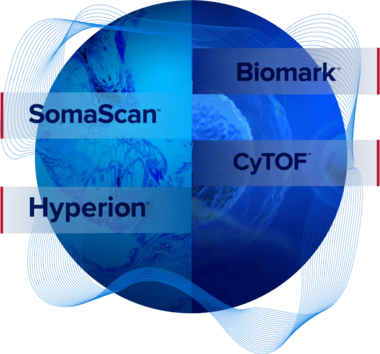Unveiling the power of multi-omics at AACR
A panel of experts discussed the critical role proteomics plays in translational and clinical oncology research – and beyond

From April 25–30, Standard BioTools was in Chicago for the 2025 AACR Annual Meeting, at which we announced the launch of new and enhanced proteomic product offerings. These advancements include the SomaScan™ Select 3.7K Assay, Single SOMAmer™ Reagents and the CyTOF™ XT PRO system, all purpose-built to support translational and clinical research across oncology and other therapeutic areas.
In addition to introducing our new product offerings, our team and collaborators presented findings that demonstrate the crucial role proteomics plays in translational and clinical oncology research, with 90 scientific posters and presentations powered by our portfolio. We also hosted a panel discussion moderated by our Chief Medical Officer, Steve Williams, MD, PhD. Lost in Omics? Navigating the Path from Protein Discovery to Healthcare Impacts featured a panel of experts discussing how a suite of Standard BioTools™ technologies has enabled them to translate biomarker findings into clinically meaningful and impactful cancer insights. Read on to learn how these researchers employ multi-omic approaches in their work:
- A collaboration between the Imperial College School of Public Health, the International Agency for Research on Cancer and SomaScan technology aims to examine proteins on a large scale. Elio Riboli, MD, MPH, HonFPH, FMedSci, of Imperial College London explains how the SomaScan Platform was used to analyze tens of thousands of samples gathered through the European Prospective Investigation on Cancer (EPIC), a long-term, large-scale study that investigates the relationships between diet, nutrition, lifestyle and environmental factors and the incidence of cancer and other chronic diseases. The case-cohort study with SomaScan technology analyzed protein measurements from 30,000 samples to help researchers better understand and predict disease development.
 When asked about the usefulness of measuring proteins, Riboli says there is much information to be gleaned from proteomics. “Why should we pay more attention to proteins that are secreted compared to proteins that come from apoptosis, that come from extracellular vesicles, that come from clones which are growing somewhere … in our body?” He says he thinks there is a lot to learn from the proteins that are in the bloodstream because they provide signals of abnormality. “If we study the normality, there will not be much excitement.”
When asked about the usefulness of measuring proteins, Riboli says there is much information to be gleaned from proteomics. “Why should we pay more attention to proteins that are secreted compared to proteins that come from apoptosis, that come from extracellular vesicles, that come from clones which are growing somewhere … in our body?” He says he thinks there is a lot to learn from the proteins that are in the bloodstream because they provide signals of abnormality. “If we study the normality, there will not be much excitement.”
Riboli hopes that in 5–10 years, prediction and early detection methods will have accelerated and there will be more progression in cancer screening, with more specific and sensitive tests. He says that looking to markers that are measured in blood may be able to point us in the right direction: “Perhaps proteomics can help also there.”
Read more about how the EPIC and SomaScan partnership reveals how lifestyle choices impact risk of chronic disease
- Brice Gaudilliere, MD, PhD, from Stanford University, examines how the human immune system adapts to clinically relevant perturbations. His lab studies multiple clinical scenarios – such as pregnancy, endometriosis and oral cancer – using a multi-pronged approach, integrating single-cell proteomic techniques with mass cytometry, Imaging Mass Cytometry™ and plasma proteomics, among others. The lab’s goal is to identify clinically relevant biomarkers that can be used for diagnosis, to determine therapeutic targets or accelerate clinical trials. Gaudilliere has used CyTOF and IMC™ technology to define immunological chronology during pregnancy, characterize postsurgical immunological insult, and explore how uterine natural killer cells modulate endometrial growth and persistence in endometriosis, among other topics.
 Gaudilliere believes that the multi-omic approach is the correct choice for his lab: “Using multiple modalities is the way to go because you’re really going to provide an understanding and a definition of what the biology is.” He says that in a single-cell state, researchers can use proteomics, transcriptomics and plasma proteomics to see what the cells are expressing. “You’re defining your system in extreme detail.”
Gaudilliere believes that the multi-omic approach is the correct choice for his lab: “Using multiple modalities is the way to go because you’re really going to provide an understanding and a definition of what the biology is.” He says that in a single-cell state, researchers can use proteomics, transcriptomics and plasma proteomics to see what the cells are expressing. “You’re defining your system in extreme detail.”
His focus for the future is on the utilization of machine learning and AI tools to help look for biomarkers. Gaudilliere says that a new application of foundation models and supervised models to understand biology at “extreme precision,” in addition to the development of single-cell atlases, is transforming translation into different types of patient prediction, pharmacological development and the acceleration of clinical trials. “It’s a different ballgame,” he says.
Read about how Gaudilliere and Standard BioTools are collaborating to bring AI-driven predictive modeling to complement CyTOF, IMC and SomaScan data
- Wendy Fantl, PhD, from Novartis, wants to address key unmet needs in ovarian and renal cancers, focusing on overcoming resistance to carboplatin-based chemotherapy; understanding poor responses to immunotherapy; and predicting severe adverse events in patients receiving immunotherapy. Her toolkit includes single-cell multiplex proteomic profiling – utilized to map cell states in complex mixtures, uncover rare populations and reveal aberrant signaling – and spatial proteomics – used to visualize protein distribution in situ and define microenvironmental niches.
 Fantl says that CyTOF technology, among other multiplex proteomic single-cell technologies, is exciting because it provides big datasets that can lead to the generation of hypotheses never previously imagined. “I think it still has tremendous value,” she says. “One of its very powerful and distinguishing features is that not only can it tell you what a cell is by surface markers, but you can go inside the cell, and you can deeply understand functions.” Fantl says that while other technologies are “fine,” she thinks that CyTOF technology is more proficient at drilling down into function, which adds value to her ovarian cancer research
Fantl says that CyTOF technology, among other multiplex proteomic single-cell technologies, is exciting because it provides big datasets that can lead to the generation of hypotheses never previously imagined. “I think it still has tremendous value,” she says. “One of its very powerful and distinguishing features is that not only can it tell you what a cell is by surface markers, but you can go inside the cell, and you can deeply understand functions.” Fantl says that while other technologies are “fine,” she thinks that CyTOF technology is more proficient at drilling down into function, which adds value to her ovarian cancer research
When asked what research breakthroughs she wants to see in 5–10 years, Fantl focuses on the complexity of cancer. She thinks that personalized treatment will mean looking to multi-omic and personalized approaches combined with consortia and international agreements. “Can we find that sweet spot?”
Read more about how Fantl has used SBI technology to investigate unanswered questions about tumor heterogeneity and immune response.
